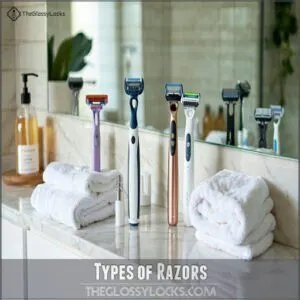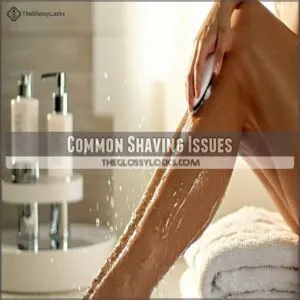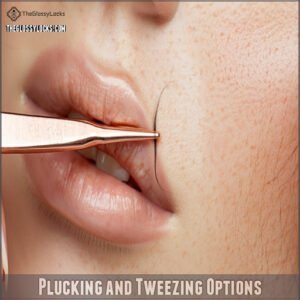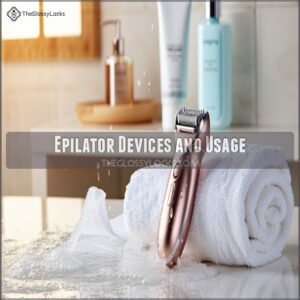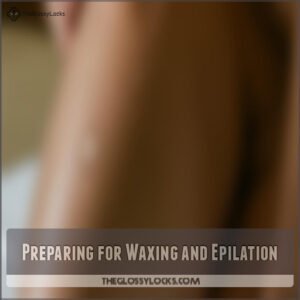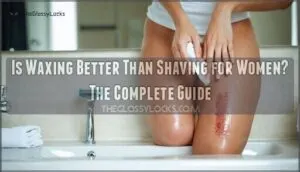This site is supported by our readers. We may earn a commission, at no cost to you, if you purchase through links.
 You’ve got options regarding hair removal methods for women.
You’ve got options regarding hair removal methods for women.
Shaving offers quick results with manual or electric razors, while tweezing works best for precise spots like eyebrows.
For longer-lasting smoothness, epilators pull multiple hairs from the root, giving you up to 8 weeks between sessions.
To prevent common issues like razor burn and ingrown hairs, use proper tools and techniques – quality shaving gels create a protective barrier, while gentle exfoliation keeps skin happy.
The secret to silky-smooth results isn’t just about the method you choose, but knowing the expert tips that make each technique work better.
Table Of Contents
- Key Takeaways
- Shaving Methods Explained
- Plucking and Tweezing Options
- Waxing and Epilation Methods
- Advanced Hair Removal Techniques
- Chemical Hair Removal Methods
- Frequently Asked Questions (FAQs)
- How do you get rid of hair permanently?
- What are the different types of hair removal methods?
- Which hair removal technique is best?
- How do I remove hair from my Skin?
- What are the different types of hair removal methods for women?
- What are the different facial hair removal methods for women?
- Which hair removal method is best for females?
- Which is the best method to remove body hair?
- Which method is better for hair removal?
- What are natural alternatives for hair removal?
- Conclusion
Key Takeaways
- You’ve got plenty of hair removal options—shaving is quick, waxing lasts weeks, and laser treatments offer long-term results.
- Prevent razor burn and ingrown hairs by using quality shaving gels and exfoliating regularly.
- Tweezing and epilators give precise or long-lasting results, but they can be time-consuming or uncomfortable.
- Prep your skin before waxing or epilation with exfoliation and ensure hair is at least ¼ inch for the best outcome.
Shaving Methods Explained
You’ll find shaving to be the quickest and most affordable way to remove unwanted hair at home, using either manual razors or electric devices that cut hair at the skin’s surface.
While the results won’t last as long as other methods, you can easily maintain smooth skin by incorporating shaving into your regular self-care routine, which helps in achieving quick results.
Types of Razors
Exploring through the maze of razor options, you’ll find both manual and electric razors designed specifically for women.
Safety razors offer precision with replaceable blades, while electric razors provide convenience with less risk of cuts.
Multi-blade cartridge razors give a close shave but may increase razor burn risk.
For sensitive areas, single-blade razors can help prevent ingrown hairs and irritation.
Shaving Creams and Gels
While you’ve got your razor ready, let’s talk about what goes between it and your skin.
The right shaving foam or gel can make all the difference in your hair removal routine. Finding the best shaving gel for women can greatly improve your shaving experience.
Gel types offer extra cushioning and visibility for tricky spots.
Skin soothers like aloe and vitamin E in razor lubricants prevent irritation. Foam ingredients including glycerin create a protective barrier.
Choose products with moisturizing elements to keep your skin happy post-shave.
Common Shaving Issues
Shaving seems simple until you encounter your first razor burn. You’ll likely face several common issues when removing hair with a razor.
From nicks and cuts to skin irritation, these challenges can make your morning routine frustrating. Here’s what you need to watch out for: Understanding shaving techniques is essential for a smooth shave.
| Issue | Cause | Solution |
|---|---|---|
| Razor Burns | Dull blades, dry shaving | Use sharp Hint, shaving cream |
| Cuts/Nicks | Pressing too hard, rushing | Light pressure, take time |
| Skin Irritation | Sensitive skin, harsh products | Use gentle products, moisturize |
| Uneven Results | Wrong angle, missed spots | Proper technique, good lighting |
| Rapid Regrowth | Cutting at surface level | Regular maintenance, proper tools |
The table outlines the common issues, their causes, and solutions to help you overcome these challenges and achieve a better shaving experience with proper technique and good lighting.
Ingrown Hairs and Prevention
Everyone dreads those pesky ingrown hairs after hair removal.
You’ll want to focus on proper exfoliation methods to keep your hair follicles clear. Gentle skin care before and after helps prevent trapped hairs – try using a soft brush or exfoliating mitt.
For aftercare tips, apply a soothing serum and avoid tight clothing. Whether you’re using depilatory creams or other hair removal methods, prevention is key.
Plucking and Tweezing Options
You’ll get precise control over unwanted hair with tweezers and epilators, which remove hair directly from the root for lasting results of up to eight weeks.
While tweezing works best for small areas like eyebrows and facial hair, modern epilator devices can tackle larger areas more quickly and efficiently, providing lasting results.
Tweezing Techniques
While shaving offers quick results, tweezing gives you precise control for targeted hair removal. The right technique makes all the difference.
Here’s how to master tweezing:
- Select slant-tip tweezers for everyday use
- Hold skin taut while plucking in the direction of growth
- Tweeze after a warm shower when pores are open
- Use natural light for best visibility
- Clean tweezers with alcohol between uses
To achieve the best results, it is essential to follow these steps carefully, as they provide a complete concept for effective tweezing.
Epilator Devices
While tweezing works for precision tasks, epilator devices offer a more efficient approach for larger areas.
These electrical tools pull multiple hairs out from the root simultaneously.
For those seeking the ideal device, researching the best epilator options can be beneficial.
| Feature | Benefit | Consideration |
|---|---|---|
| Electric motor | Removes many hairs at once | Can be painful at first |
| Rechargeable options | Use in/out of shower | Higher upfront cost |
| Attachments | Reaches difficult areas | May cause irritation |
| No chemicals | Long-lasting results (3-4 weeks) | Not suitable for all body parts |
To reduce discomfort, try using a slower speed setting or taking a hot shower beforehand. This can help make the epilation process more efficient and less irritating.
Plucking Individual Hairs
While epilators can tackle multiple hairs at once, plucking individual hairs offers precision that’s hard to beat.
With just a pair of tweezers, you can target even the finest hairs—especially useful for eyebrow shaping and facial hair removal.
For longer-lasting results, consider professional threading techniques.
Plucking pain varies by area, but hairs typically take longer to regrow (two to eight weeks) since you’re removing them from the follicle. Be gentle to avoid ingrown hairs and unwanted scarring.
Suitable Areas for Tweezing
For precision hair removal, tweezing works best on small, targeted areas.
Your eyebrows benefit most from careful tweezing—it’s perfect for brow shaping and maintaining your desired arch.
The upper lip, chin, and stray facial hairs also respond well to tweezers.
You’ll want to avoid tweezing larger areas like underarms, as it’s time-consuming and potentially painful, and instead stick to small patches where you need careful control, especially for precision hair removal.
Waxing and Epilation Methods
You’ll find longer-lasting results with waxing and epilation methods, which remove hair directly from the root for up to six weeks of smoothness.
Whether you choose traditional waxing or modern epilator devices, you’ll need to let your hair grow about 1/4 inch long for the best results.
Hot and Cold Waxing
While tweezing works for small areas, waxing lets you tackle larger zones in one go.
Hot waxing uses warm wax that adheres to hair, while cold waxing strips come ready to use.
You’ll need hair that’s at least ¼ inch long for best results. Both methods pull hair from the root, giving you smooth skin for 3-6 weeks.
Remember to test for skin sensitivity first.
Epilator Devices and Usage
While waxing requires regular salon visits, you’ll love the convenience of epilator devices for at-home hair removal.
These handy electrical tools grasp multiple hairs simultaneously, pulling them from the root. You can find the best epilator devices online.
You can reduce discomfort by using your epilator after a warm shower or applying numbing cream. Modern epilators are rechargeable and often waterproof, making them perfect for shower use with optional gels to minimize irritation.
Threading and Its Benefits
Looking for a gentle way to remove facial hair? Threading uses a twisted cotton thread to pull unwanted hair from the root, offering precise control and clean results.
Here are five key benefits of this traditional hair removal technique:
- Perfect for sensitive skin – no chemicals or heat required
- Provides detailed shaping for eyebrows
- Results last up to 6 weeks
- More precise than waxing
- Less irritation than other methods
Threading is particularly advantageous due to its gentle nature, making it an ideal choice for those seeking a method with minimal irritation.
Preparing for Waxing and Epilation
Your skin’s preparation makes all the difference in waxing and epilation success.
Before any at-home hair removal session, make sure hair length reaches ¼ inch for best results. Gently exfoliate 24 hours prior to prevent ingrown hairs, but avoid harsh scrubs.
Keep the area clean and dry, applying a soothing pre-wax oil for follicle care.
Skip waxing if you’re using retinoids or have sunburned skin.
Advanced Hair Removal Techniques
You’ll find advanced hair removal methods like laser treatment, electrolysis, and IPL offer longer-lasting results than traditional options.
These professional techniques target hair at the follicle level, reducing growth over time and giving you months or even years of smooth skin.
Electrolysis Procedure
While waxing offers temporary results, electrolysis hair removal stands as the only FDA-approved permanent hair removal method.
During treatment, your certified electrologist uses a tiny probe to deliver electrical currents directly to each hair follicle, ensuring permanent destruction.
- Initial consultation costs range from $50-100
- Each session typically runs $45-100 per hour
- Treatment plans vary from 6-18 months
- Complete follicle destruction occurs in 1-4 sessions per area
Laser Hair Removal Process
While electrolysis targets individual follicles, laser hair removal offers broader coverage using concentrated light beams.
Your melanin absorbs this light, converting it to heat that damages hair follicles. A detailed laser procedure explains this process further.
You’ll need 6-7 treatment sessions for ideal results, and it works best if you have light skin and dark hair. Though pricier than other methods, you’ll notice thinner, finer regrowth over time.
Intense Pulsed Light Therapy
IPL hair removal harnesses intense pulsed light to target your hair’s melanin, effectively reducing unwanted growth.
You’ll likely need multiple sessions for best results, but IPL benefits include being gentler and more cost-effective than laser treatments.
This IPL therapy improves skin color and texture.
This light therapy works best if you have lighter skin and darker hair, and while it’s not permanent hair removal, you notice significant reduction over time.
Comparing Advanced Methods
When choosing between advanced hair removal methods, you’ll find electrolysis offers permanent results but comes with higher costs and longer treatment times.
Laser treatments work best for light skin and dark hair, providing long-lasting results over 4-6 sessions.
IPL treatments offer lower costs than laser, though they’re less effective, and each method targets hair follicles differently.
So, consult a professional to determine your best option, and understanding the laser hair removal process is essential for making an informed decision about your hair removal needs.
Chemical Hair Removal Methods
You’ll find chemical hair removal methods to be a convenient alternative that dissolves unwanted hair right at the surface of your skin.
While depilatory creams can work in as little as 5 minutes, you’ll need to do a patch test first and follow the instructions carefully to avoid skin irritation.
Depilatory Creams and Gels
While advanced treatments offer lasting results, you’ll find depilatory creams and gels provide a quick, pain-free option for hair removal.
These chemical hair dissolvers break down protein bonds in your hair, making it easy to wipe away.
- Test a small patch 24 hours before full application
- Apply cream evenly with the supplied spatula
- Wait 3-10 minutes (never exceed suggested time)
- Wipe off in the opposite direction of hair growth
- Rinse thoroughly with cool water
Prescription Hair Growth Inhibitors
While depilatory creams offer quick results, prescription hair growth inhibitors like Vaniqa (eflornithine) work differently by targeting hair growth at its source.
This FDA-approved cream blocks specific enzymes that fuel hair growth, making it particularly effective for facial hair in women.
Clinical studies show it works for 58% of users after 24 weeks, and you’ll need to apply it twice daily, with results that can last up to eight weeks using hair growth inhibitors like this, providing a solution that can be effective for facial hair.
At-Home Chemical Hair Removal
For those seeking a gentler approach to hair removal, at-home chemical depilation offers a pain-free solution.
Hair removal creams and depilatories work by breaking down hair proteins, making unwanted hair easy to wipe away. Matching the cream to your specific hair texture is important for best results.
- Choose products designed for your specific body area
- Always perform a patch test 24 hours before use
- Apply cream evenly with the included spatula
- Never exceed recommended application time
- Rinse thoroughly with cool water
Frequently Asked Questions (FAQs)
How do you get rid of hair permanently?
To permanently remove hair, try electrolysis or laser hair removal.
Electrolysis destroys follicles with electricity, while lasers target melanin to inhibit regrowth.
Both require multiple sessions, can be pricey, but offer long-lasting, effective results.
What are the different types of hair removal methods?
You’ve got options! Shaving, plucking, waxing, threading, and epilators offer temporary fixes.
For longer-lasting results, try laser hair removal or electrolysis.
Chemical creams and prescription treatments can also help, but always follow safety guidelines to ensure complete safety.
Which hair removal technique is best?
The best hair removal technique depends on your needs.
Shaving is quick, waxing lasts longer, and laser offers semi-permanent results.
Consider your pain tolerance, budget, and how much time you’re willing to invest.
How do I remove hair from my Skin?
Removing hair depends on your preference and skin type.
Shave for quick results, wax for longer-lasting smoothness, or try creams for ease.
Always test products first, follow instructions, and moisturize to avoid irritation.
What are the different types of hair removal methods for women?
You can try shaving, waxing, tweezing, depilatory creams, or advanced methods like electrolysis or laser removal, each with its pros and cons, to find what works best for you.
What are the different facial hair removal methods for women?
You can use tweezing, waxing, depilatory creams, or prescription creams to remove facial hair, each with its own benefits and potential side effects to evaluate for safe removal.
Which hair removal method is best for females?
Imagine smooth skin without the fuss.
The best method depends on your needs—shaving is quick, waxing lasts weeks, and laser offers long-term results.
Always consider your skin type, budget, and pain tolerance.
Which is the best method to remove body hair?
The best body hair removal method depends on your needs.
Shaving is quick and cheap, waxing lasts longer, and laser offers semi-permanent results.
Consider your pain tolerance, budget, and how long you want results.
Which method is better for hair removal?
It depends on your needs.
For quick, painless results, shaving works well.
Want longer-lasting smoothness? Waxing or epilators may suit you.
For permanent solutions, laser or electrolysis shine.
Choose based on time, cost, and comfort.
What are natural alternatives for hair removal?
Try sugaring, a mix of sugar, lemon, and water.
It’s gentle, natural, and works like waxing.
Turmeric pastes or papaya masks can slow growth over time.
Always patch-test for allergies before trying anything new!
Conclusion
Mastering hair removal methods for women might feel like solving a puzzle, but it’s simpler than you think.
Whether you prefer quick fixes like shaving or long-term solutions like laser treatments, there’s an option for every lifestyle and skin type.
Remember, proper tools and techniques matter—avoid razor burn with quality gels or prevent ingrown hairs by exfoliating.
Explore methods that fit your needs, and you’ll enjoy smoother, happier skin with less hassle. Your perfect routine awaits!
- https://us.braun.com/en-us/female-hair-removal-tips/hair-removal-methods
- https://www.businessinsider.com/guides/beauty/best-bikini-hair-removal-products
- https://www.womenshealthmag.com/beauty/g38828659/best-laser-hair-removal-devices/
- https://www.aad.org/public/kids/hair/how-hair-grows
- https://www.mayoclinic.org/tests-procedures/laser-hair-removal/about/pac-20394555

